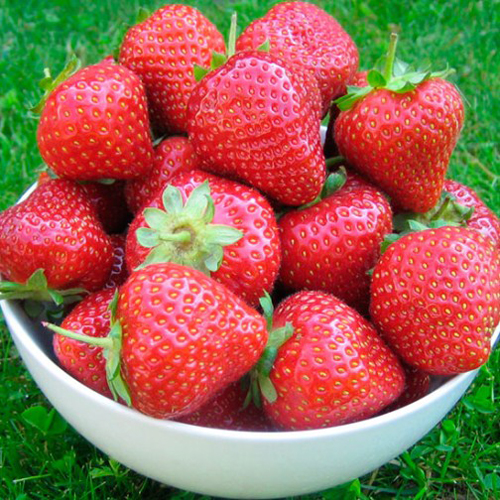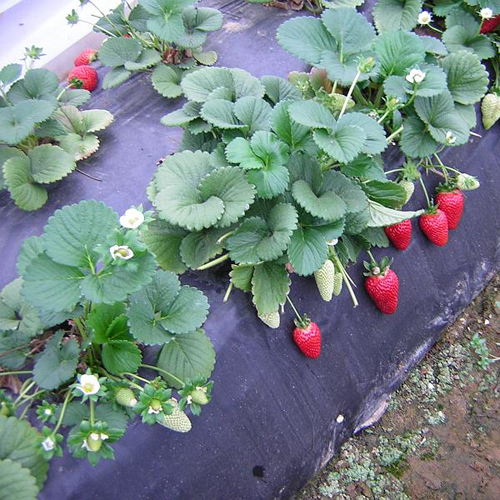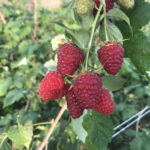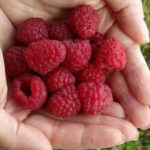Strawberry variety Molling Opal
Molling Opal is a remontant variety of garden strawberries (strawberries) for universal use. It was bred in the UK by specialists from the renowned East Malling Research Station. The author was D. Simpson, who presented us with other masterpieces of strawberry breeding (Molling Pandora, Florence, etc.). The complex pedigree of our hero includes such famous specimens as Elsanta, Providence, Etna, Evita, Selva... In 2001, the first plants of the new cultivar were selected and tested as a numbered choice EMR287. After 4 years, the variety was officially registered and patented and began to be actively distributed. Molling Opal immediately fell in love with farmers and gardeners for its excellent taste and high yield; this strawberry can rightfully be called one of the best among remontant strawberries, as it has an optimal ratio of consumer and productive characteristics. But, of course, it also has flaws, which we will talk about below.
The plant is powerful, tall, abundantly leafy, semi-spreading. The formation is quite abundant, which is a rarity for remontants, so this nuance can be immediately attributed to the disadvantages of Opal's Molling. The leaves are large, medium-wrinkled, bright green in color. The denticles of the edges of the leaf plate are large. The flowers are bisexual, white. Peduncles are long, thick, with weak pubescence, located at the level of leaves or below. An abundant amount of fruits is formed on the stems of strawberries, which is why they lie on the ground.

The berries of the variety are large, of the correct conical shape, they are distinguished by uniformity and uniformity in size. The skin is firm, bright red, shiny. Achenes are yellow, superficial. The flesh is red, moderately firm, without apple crunch on the bite, fleshy, very juicy, with a delicate fibrous consistency and a wonderful bright strawberry aroma. It should be said that such a "set" of characteristics is very rare for popular remontants, due to which Molling Opal immediately attracts attention against their background.
The taste of the berries is very sweet, harmonious, with a delicate hint of sourness that perfectly complements the palette. In terms of the mass fraction of sugar in the pulp (Brix), our hero surpassed the very popular remontant Everest. Strawberries really stand out for their taste among other remontant varieties, it just doesn't turn out to call its fruits "foam plastic". In addition, the variety does not belong to the solid, which is often very typical for remontants, it has an excellent tender pulp, and besides, it is very fragrant, which adds to the attractiveness of Molling Opal against the background of other "workhorses" on the site. By the way, it should be noted that the density of the pulp is quite enough to safely transport the crop to the point of sale. Thus, our hero is good at everything, will please both a simple gardener and a farmer. The berries are versatile in use, excellent fresh, suitable for any processing, and also excellent for freezing.
The average weight of strawberries is 25-30 grams, sometimes larger specimens are observed, however, in the total mass, the berries are rather one-dimensional, not inclined to become smaller, as befits a remontant variety. Of course, with gross mistakes in agricultural technology, the fruits may decrease in size, so it is necessary to regularly pay enough attention to the plants. The yield of Molling Opal is high, according to some sources, in this regard it even surpasses the "giants" of the range of remontants - Albion, San andreas and Monterey... Thus, we are talking about indicators of 3 kg per plant and even more.However, it should be understood that such high results are achievable only with truly ideal agricultural practices, including regular abundant feeding with a cocktail of fertilizers and growth stimulants, as well as high-quality disease prevention and strict control over environmental conditions. As for simple gardeners who do not seek to squeeze the maximum out of plants, they may well rely on 1 kg of berries from a bush with moderate agricultural technology. In general, the yield of strawberries is extremely dependent on the region in which it grows, but we will talk about this a little below.

In the fruiting of Molling Opal, 4 waves are distinguished, the main one begins around July. In general, the variety bears fruit practically without interruption from the first or second decade of June to November. In protected ground, the season can stretch for a longer time. It is difficult to indicate a specific ripening period for the first wave of the crop in the open field, because in different regions it begins at radically different periods. So, in its homeland, strawberries ripen in mid-May, along with the early varieties, but in the Moscow region it already behaves like a mid-early, or mid-season, in more northern regions it can start the season generally in the third decade of June, when they are about to ripen first mid-late varieties. During the tests of Molling Opal, the following percentage of the yield of berries was observed: in July-August, the plants give 60% of the total harvest, in September-October - 40%. By the way, seedlings planted in spring will bring their first harvest in June.
The variety is resistant to powdery mildew, and this is perhaps the only point of its invulnerability. It is weakly resistant to spots, late blight, root rot and other fungal diseases. Thus, Molling Opal is in dire need of high-quality regular protection from diseases, and one cannot do without "chemistry", especially in unfavorable seasons. In general, our hero's relationship with the climate is very difficult, so which season can be called unfavorable for him is a rather interesting question. In cold rainy periods, plants suffer from fungal diseases up to attacks, the fruits become either tasteless or even too sour. In hot seasons, it also does not do without attacks, which gardeners from the southern regions complain about, and “compote” instead of berries brings a lot of disappointment - they are heavily baked in the sun.
Strawberry winter hardiness is insufficient, in the northern regions there is a high probability of freezing and death of plants even under shelters. In milder climates, the variety winters better, but everything also needs good shelter. This is also true for the spring period - it is better to use covering materials to avoid surprises, and in the fall they are often required. In general, in the northern regions with a cold climate, Molling Opal can fail completely and lose even to less productive varieties. The fact is that the 40% of the crop that plants should give back after the arrival of September is often simply unrealistic to get due to the onset of cold weather. But, of course, there is a way out, and even the originators are talking about it - they advise using tunnel shelters, moreover, in all regions. In general, strawberries will best reveal their potential only under controlled conditions, in the northern regions this almost 100% means growing only in heated greenhouses.

Not only is the capricious Englishman Molling Opal too sensitive to weather fluctuations, he is also picky about the soil. He does not tolerate carbonate soils, he often suffers from chlorosis and bears fruit with frankly sour berries. Plants feel best on soils with neutral acidity, in extreme cases on slightly acidic ones.Thus, the soil pH should be in the range of 5 - 6.5.
The variety is very whimsical to care for, it requires very high-quality agricultural technology. If you are not ready to really fight hard for the harvest, then this strawberry is clearly not your option. We will try to briefly list the most basic nuances of growing and care.
- Planting is preferably done in spring, especially in regions with cold climates, since young plants overwinter extremely badly, and your entire plantation, planted in autumn, may simply die.
- Molling Opal bushes are planted at a distance of 35-40 cm from each other, excessive thickening leads to an increased risk of fungal diseases and a decrease in yield due to lack of nutrition. It is recommended to plant no more than 29 thousand plants per hectare of area.
- It is extremely important to timely and efficiently carry out all standard maintenance techniques - weeding, loosening the soil, watering and feeding, preventive treatments against diseases and pests. The variety does not like waterlogging, but it does not tolerate dry periods well, so the installation of a drip irrigation system would be the best solution.
- Top dressing should be discussed separately. It is very important to provide the plants with adequate nutrition, otherwise you will clearly be disappointed in Molling Opal. The variety, of course, is extremely capricious, but it responds to very painstaking care with a really huge high-quality yield. The game is worth the candle, so don't skimp on fertilizer. It is especially important to provide strawberries with mineral complexes so that the taste and size of the berries please you. Foliar dressing is also relevant, good results are obtained by alternating fertilization at the root (watering) and on the leaf (spraying).
- Another very important point is the need for annual plantation renewal. Plants can be used for a maximum of two years, but to obtain the highest yields, plantings should be rejuvenated every year. The variety develops its resource very quickly, so you should not expect from it that it cannot bear fruit in the third year. In addition, given the weak immunity of the variety, it is clearly not worth delaying the renewal of the planting material, the constant fight against emerging diseases will not pay off.
- And the last thing. Molling Opal is prone to the formation of a large number of mustaches, so their number needs to be normalized. In general, this can cause some bewilderment - how is a remontant with such productivity potential able to form a lot of mustache? Of course, at the time of abundant fruiting, this will not be particularly noticeable, but when the plant "burrs" strongly, it will be too late. The best solution would be to split the landings. On one site, a mother plant is organized, where strawberries are not allowed to bear fruit, plucking flowers so that it “works” for reproduction. On another site, the bushes are not allowed to waste energy on the mustache, removing them to get maximum yield.
Let's summarize. Summarizing all of the above, one can involuntarily wonder whether it is worth purchasing this variety at all, since it is so capricious and unreliable? If you are ready to fight for the harvest, then definitely worth it! As already mentioned, he is really capable of breaking productivity records, so all your efforts will not be in vain. Of course, if you do not strive to get huge yields, but just want to settle a remontant on the site, which will delight you with tasty stable yields for a long time, then Molling Opal is clearly not what you need. The choice is huge now, so it's better to take a look at another variety right away. Moreover, this strawberry reacts quite sharply to the most minimal mistakes in agricultural technology, and less whimsical, albeit not so productive, varieties can even bypass it in productivity and taste with the same imperfect care.









I have always been light on the remontant varieties of garden strawberries - yes, there are berries, large, beautiful, but completely tasteless. But, as they say, when there is no other, and this one is good (I think that in the autumn months any berry is a joy), so I had few rems - only 4 varieties. When I was offered to take a couple of tendrils of this strawberry, I thought for a long time - why? But then I took it and planted it - how I was amazed by the taste of the berries! They are firm, but not firm, while the flesh literally "melts in your mouth." The yield at Molling Opal is excellent, it is resistant to diseases, it winters well. I skip the first strawberry crop - I remove the flower stalks, thereby increasing the second (main) crop in the second half of summer - in the fall.